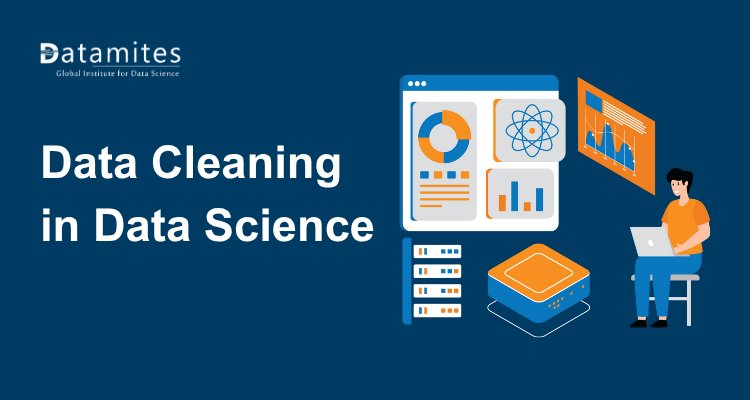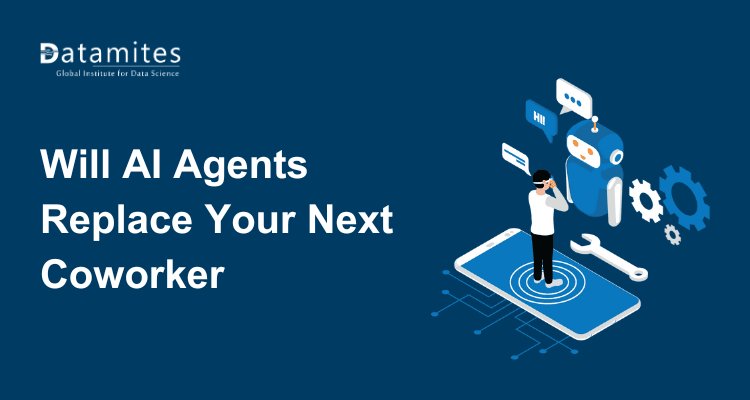Data Cleaning in Data Science: What It Is and Why It Matters
Discover the importance of data cleaning in data science. Learn how removing errors, duplicates, and inconsistencies ensures accurate analysis, improves model performance, and leads to better decision-making in real-world applications.

Let’s face it, data is everywhere. But just because there’s a ton of data doesn’t mean all of it is useful. That’s where data cleaning comes in. Think of it as the housekeeping part of the data science pipeline. Not the flashiest step, but one that can make or break everything that comes after.
In the world of data science, clean data is the foundation. Whether you're just starting out with a data science course, exploring applications of data science, or aiming to become a data scientist, understanding the data cleaning process is essential. It’s not optional; it’s non-negotiable.
As demand for data science continues to grow, IDC predicts that by 2025, global data creation will hit 180 zettabytes, the importance of data cleaning can’t be overstated. You want actionable insights, not garbage. And garbage in equals garbage out.
What Is Data Cleaning in Data Science?
Data cleaning, sometimes called data cleansing or scrubbing, is the process of identifying and fixing errors, inconsistencies, duplicates, and irrelevant entries in a dataset. It’s a key part of data preprocessing that ensures the data is accurate, consistent, and ready for analysis or modeling. This step often involves handling missing values, correcting category mismatches, removing outliers, and standardizing formats so the dataset is actually usable.
Anyone who's worked with real-world data knows how much time this can take and how crucial it is. According to IBM and CrowdFlower, data scientists spend 60% to 80% of their time on data cleaning and preparation. It’s not glamorous, but it’s foundational. Without clean data, even the most sophisticated algorithms won’t deliver meaningful results.
Why Is Data Cleaning Important?
Because everything in data science starts with clean data. If the input is messy, your analysis is off, your models miss the mark, and your decisions fall apart.
- According to a 2025 Kaggle survey, over 50% of a data scientist's time is still spent on data cleaning and preparation.
- IBM estimates that bad data costs the US economy $3.1 trillion annually due to poor decision-making and operational inefficiencies.
Clean data drives everything, fraud detection, forecasting, customer insights. That’s why learning to clean it well is foundational in any data science path. No surprise the Data Cleaning Tools Market is projected to grow from $2.5B in 2024 to $6.8B by 2033 as per Verified Market Report.
Refer these articles:
- The Rise of Data Science in the Agriculture Industry
- The Role of Data Science in Cyber Security: Use Cases and Trends
- Difference Between a Data Scientist and Business Analyst
Common Mistakes to Avoid When Cleaning Data
Even seasoned professionals mess this up sometimes. Here are the pitfalls to watch out for:
- Not backing up raw data: Always keep an untouched copy. You’ll need it if something breaks or you need to start over.
- Overcleaning the data: Removing too many outliers or odd values can erase important information. Clean with context.
- Blindly filling missing values: Imputing without understanding why data is missing can introduce bias or distort patterns.
- Ignoring data types: Treating dates as text or numbers as strings can silently break your analysis and models.
- Hardcoding fixes: One-off manual fixes don’t scale. Use scripts that are repeatable and easy to update.
- Skipping visual inspection: Summary stats won’t catch everything. Graphs often reveal hidden errors or outliers.
- Failing to document changes: If you don’t track what you did, you (or your team) won’t know what went wrong later.
Avoiding these mistakes is key to building a robust data preparation workflow and improving the quality of your data science projects.
Step-by-Step Guide to the Data Cleaning Process
Cleaning data isn’t glamorous, but it’s essential. Here’s how data scientists approach it step by step, whether they're working on real-world projects or practicing through a data science course.
Load and Inspect the Data
Start by importing your dataset and checking for missing values, inconsistent formats, or unusual patterns using summaries and visualizations.
Remove Duplicates
Duplicates skew results and can mislead models. Use tools like drop_duplicates() in pandas to clean them out.
Handle Missing Values
One of the most common data quality issues. You can:
- Drop rows or columns with too many missing values
- Fill them using mean, median, mode, or interpolation
- Flag them for special handling
What you choose depends on the data context, something emphasized heavily in any solid data science training.
Fix Structural Errors
Correct typos, inconsistent labels (like “NY” vs “New York”), and wrong data types to ensure clean, usable categories.
Standardize and Normalize
Use z-score or min-max scaling to put data on a consistent scale, essential for many ML algorithms.
Address Outliers
Detect outliers using visual tools (box plots, scatter plots) or stats (IQR, Z-score) and decide whether to remove or cap them.
Validate and Document
Recheck everything. Log your steps clearly, especially if you’re working in teams or building a portfolio during a data science course.
Automate the Workflow
Use Python scripts or tools like Airflow to automate repetitive cleaning tasks. Automation is a key skill in any data science career.
This structured approach to cleaning data is a fundamental part of the data science pipeline. Mastering it will help you avoid common mistakes, improve data quality, and set yourself apart, whether you're a beginner or working through an offline data science course.
Refer these articles:
- Top Data Science Trends to Watch in 2025
- How the Financial Sector is Leveraging Data Science
- Getting Started with Python for Data Science
Best Data Cleaning Tools and Techniques for Data Scientists
If you’re serious about data science, data cleaning isn’t optional. Whether you're learning, training, or working with real data, these tools and techniques help you clean faster and smarter.
Top Data Cleaning Tools
These tools are widely used by data scientists to clean, transform, and prepare datasets efficiently.
- Pandas (Python): The core data cleaning library in Python. Use it to drop nulls, fix duplicates, reformat columns, and reshape messy datasets quickly.
- OpenRefine: Great for cleaning messy text data, fixing inconsistencies, and clustering similar values. Ideal for non-coders working with tabular data.
- Trifacta: A visual tool that helps automate data wrangling with smart suggestions. Good for large datasets and team workflows.
- Tableau Prep: Best for users already working in Tableau. It allows quick filtering, joining, and reshaping of data before building dashboards.
- SQL: Still essential. Use it to filter rows, join tables, remove duplicates, and handle nulls directly in structured databases.
Essential Data Cleaning Techniques
Mastering these techniques is key to improving data quality and building reliable models.
- Handling missing values: Drop, fill, or interpolate based on context. Don’t guess, understand why values are missing.
- Removing duplicates: Duplicates distort results. Drop them early to keep your data clean.
- Fixing structural errors: Standardize typos, inconsistent labels, and formats to avoid broken categories.
- Dealing with outliers: Use IQR, Z-score, or visuals to detect them. Don’t remove without a reason.
- Standardizing and normalizing: Scale numeric values for better model performance and training stability.
- Correcting data types: Always assign proper types, dates, numbers, and text must be stored correctly.
- Encoding categorical variables: Convert text to numbers with label or one-hot encoding for modeling.
- Automating cleaning steps: Script routine tasks with Python or Airflow to save time and reduce errors.
Anyone looking to become a data scientist or level up in their data science career should be fluent with these data cleaning techniques and tools.
Refer these articles:
Proven Best Practices for Data Cleaning
Here’s what actually works when you're dealing with real-world data:
- Clean iteratively: New data issues often show up during analysis or modeling. Expect to revisit your cleaning steps.
- Understand your data first: Don’t jump into cleaning without exploring the dataset. Know what each column means and why issues exist.
- Automate repetitive tasks: Use Python scripts, functions, or pipelines to avoid manual cleaning every time.
- Use version control: Track every change with Git or similar tools so you can undo mistakes or compare versions.
- Validate after cleaning: Check summaries, plots, and data types to make sure your fixes didn’t break anything.
- Document your process: Write down what you did and why. It saves time later and helps with team collaboration.
- Visualize your data: Use histograms, box plots, and scatter plots to catch outliers, weird values, or patterns that don't show in raw numbers.
- Consult domain experts: Sometimes what looks wrong is actually valid. Ask someone who understands the subject matter.
- Prioritize key fields: Focus your cleaning efforts on the data that drives your analysis or model, not everything needs to be perfect.
- Test your outcomes: A cleaned dataset should improve your model accuracy or insight quality. Always check the downstream effect.
Practicing these consistently will help you stand out, especially if you're pursuing data science for beginners or considering enrolling in a data science institute.
Data cleaning in data science isn’t just a side task, it’s foundational. It underpins the integrity of everything from analytics dashboards to machine learning models. And it’s one of the most sought-after skills in data science training programs and hiring assessments.
The scope of data science is massive, and the future of data science is only getting more data-heavy. If you're serious about a career in data science, mastering the data cleaning process is non-negotiable.
You can learn tools and techniques from an online or offline data science course, but the real growth comes from doing, over and over. Choose a data science institute in Bangalore that emphasizes hands-on projects. Build your own workflows. Experiment with messy, real-world datasets.
DataMites Institute has carved out a reputation for producing job-ready data professionals with a clear focus on what the industry actually needs. If you're looking to build a career in data science, whether it's in tech, e-commerce, or business intelligence, this place is built for it. The curriculum goes beyond theory, emphasizing real-world projects and live internships that prepare you to hit the ground running.
DataMites Certified Data Scientist courses are globally recognized, backed by IABAC and NASSCOM FutureSkills. Training covers everything from machine learning and AI to business analytics and essential data science tools. These are the skills that drive real impact, helping businesses sharpen customer insights, optimize operations, and make smarter decisions through data.
If you prefer learning in a classroom, DataMites offers offline data science classes in Pune, Delhi, Bangalore, Chennai, Hyderabad, Mumbai, Coimbatore, and Ahmedabad. Prefer online? That’s covered too, with flexible and comprehensive virtual programs for learners across the globe. Whether you're just starting out or leading a team that needs to get up to speed, DataMites offers the kind of practical, relevant training that turns knowledge into results.





